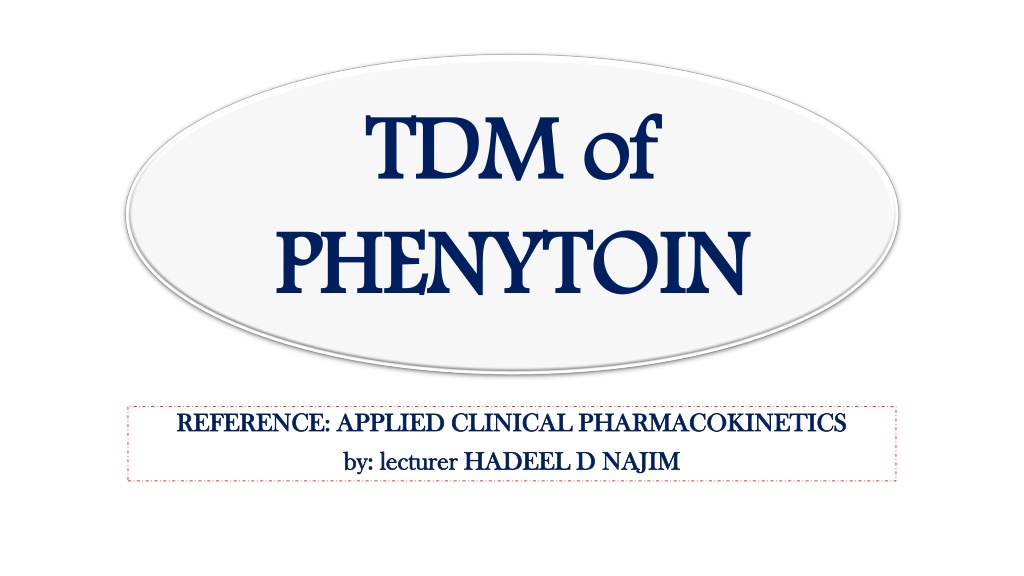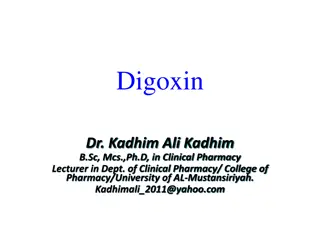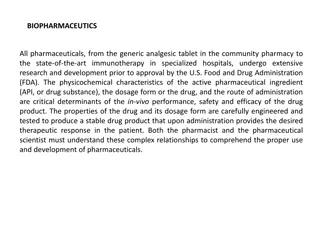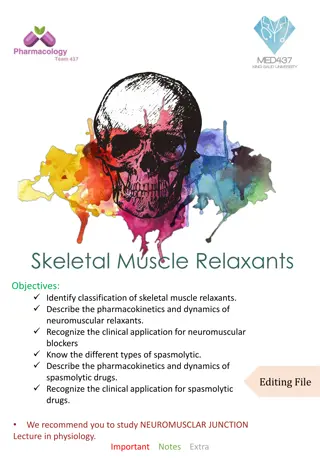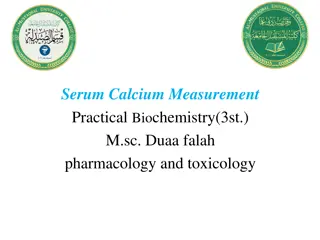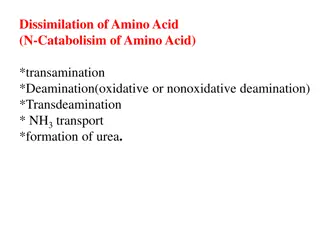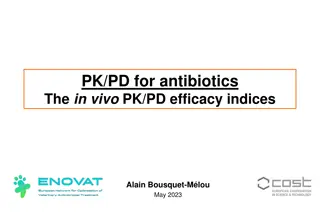Understanding Phenytoin Therapy - Clinical Pharmacokinetics and Serum Concentrations
Phenytoin, a medication with high protein binding and hepatic metabolism, exhibits saturated pharmacokinetics with a narrow therapeutic range of 10-20 µg/mL for total serum concentrations. Adverse effects vary with serum levels: minor CNS depression at >15 µg/mL, nystagmus at >20 µg/mL, and ataxia/mental changes at higher levels. Displacement factors affecting albumin binding can increase the unbound fraction, impacting drug efficacy. Monitoring serum levels and understanding factors affecting protein binding are crucial in optimizing phenytoin therapy.
Download Presentation

Please find below an Image/Link to download the presentation.
The content on the website is provided AS IS for your information and personal use only. It may not be sold, licensed, or shared on other websites without obtaining consent from the author. Download presentation by click this link. If you encounter any issues during the download, it is possible that the publisher has removed the file from their server.
E N D
Presentation Transcript
TDM of PHENYTOIN TDM of PHENYTOIN REFERENCE: APPLIED CLINICAL PHARMACOKINETICS REFERENCE: APPLIED CLINICAL PHARMACOKINETICS by: lecturer HADEEL D NAJIM by: lecturer HADEEL D NAJIM
Phenytoin is Phenytoin is high protein bound ( high protein bound (~ ~90 90%) %) Phenytoin is Phenytoin is eliminated by hepatic metabolism (> eliminated by hepatic metabolism (>95 95%). %). Phenytoin Phenytoin Menten or saturable pharmacokinetics. pharmacokinetics. follows follows Mechalis Mechalis- -Menten or saturable
Therapeutic serum concentrations Therapeutic serum concentrations Phenytoin is high protein bound ( Phenytoin is high protein bound (~ ~90 Unbound fraction (fB) of phenytoin is ( Unbound fraction (fB) of phenytoin is (~ ~10 90%) %) 10%) %) The therapeutic range for total (unbound + bound) phenytoin serum concentrations in the treatment of seizures is The therapeutic range for total (unbound + bound) phenytoin serum concentrations in the treatment of seizures is 10 10- -20 20 g/mL g/mL Unbound phenytoin serum concentrations Unbound phenytoin serum concentrations 1 1 2 2 g/ g/mL mL. .
Adverse effects related to serum conc. Adverse effects related to serum conc. >15 >15 g/mL g/mL - ------- ------ minor central nervous system depression such as drowsiness or fatigue. minor central nervous system depression such as drowsiness or fatigue. > 20 > 20 g/mL g/mL - -------- ------- nystagmus nystagmus, lateral gaze , lateral gaze > 30 > 30 g/mL g/mL - -------- ------- ataxia, slurred speech, and/or incoordination ataxia, slurred speech, and/or incoordination > 40 > 40 g/mL g/mL - ------ ----- mental status changes, including decreased mentation, severe confusion mental status changes, including decreased mentation, severe confusion or lethargy, and coma are possible. or lethargy, and coma are possible. > 50 > 50 g/mL g/mL -------- --------Drug Drug- -induced seizure activity. induced seizure activity.
Since phenytoin is highly bound to albumin, you need to know Since phenytoin is highly bound to albumin, you need to know factors cause its displacement from binding site factors cause its displacement from binding site------- -------which lead which lead to increase unbound fraction ( to increase unbound fraction ( f fB B) ) ( (1 1) Lack of binding protein due to insufficient plasma conc. of ) Lack of binding protein due to insufficient plasma conc. of ( ( albumin), albumin), ( (2 2) Displacement of phenytoin from albumin binding sites by ) Displacement of phenytoin from albumin binding sites by endogenous endogenous compounds, compounds, ( (3 3) Displacement of phenytoin from albumin binding sites by ) Displacement of phenytoin from albumin binding sites by exogenous exogenous compounds compounds
Clinical Usefulness of Unbound Phenytoin Clinical Usefulness of Unbound Phenytoin Concentrations Concentrations Unbound phenytoin concentrations are an extremely useful monitoring Unbound phenytoin concentrations are an extremely useful monitoring tool when used correctly. tool when used correctly. The relationship between total concentration (C), unbound or The relationship between total concentration (C), unbound or free concentration (C concentration (Cf f ), and unbound or ), and unbound or free free free fraction (f fraction (fB B) is: ) is: C Cf f = f = fB B .C .C
Therapeutic drug Therapeutic drug monitoring of phenytoin conc. monitoring of phenytoin conc. Total phenytoin serum concentrations is the mainstream way for Total phenytoin serum concentrations is the mainstream way for routine therapeutic drug monitoring purposes. routine therapeutic drug monitoring purposes. Unbound phenytoin serum concentration monitoring restricted to Unbound phenytoin serum concentration monitoring restricted to patients with known reasons to have altered drug plasma protein patients with known reasons to have altered drug plasma protein binding. binding.
(C=5 5 g/mL), reason would would be be abnormal reason For For example example,, if if llow ow total satisfactory satisfactory anticonvulsant anticonvulsant response, protein protein binding binding (f (fB B = = 20 20% %) ) for for some total phenytoin phenytoin concentration response, one some unidentified unidentified reason concentration (C= one possible possible reason g/mL), and and patient patient has abnormal plasma has a a plasma C Cf f = f = fB B .C .C 0.2 . . 5 5 ------ g/mL ------ C Cf f = = 0.2 C Cf f= = 1 1 g/mL ------ not within therapeutic range not within therapeutic range ------ within therapeutic range within therapeutic range
Conversely,,,, Conversely,,,, If a patient has a possible phenytoin If a patient has a possible phenytoin- -related adverse drug reaction and the total phenytoin concentration is within the therapeutic range ( total phenytoin concentration is within the therapeutic range (15 15 g/mL), A possible reason could be abnormal protein binding ( A possible reason could be abnormal protein binding (20 20%) for an unidentified reason, unidentified reason, C Cf f = f = fB B .C .C = = 0.2 0.2 15 15 g/mL g/mL ------ ------ within therapeutic range within therapeutic range = = 3 3 g/mL g/mL ------ ------ toxic toxic related adverse drug reaction and the g/mL), %) for an
Methods to estimate unbound phenytoin Methods to estimate unbound phenytoin concentrations (C concentrations (Cf f) ) 1 1- -Normalized total phenytoin concentration Normalized total phenytoin concentration C Normal Binding = C /(X Alb + 0.1) NormalBinding C is the actual measured phenytoin concentration in g/mL , X is a constant equal to: 0.2 0.25 0.1 Alb is the albumin concentration in g/ C CNormal C is the actual measured phenytoin concentration in X is a constant equal to: Alb Binding is the normalized total phenytoin concentration in is the normalized total phenytoin concentration in g/mL, g/mL, g/mL , 0.2 (if protein binding measurements conducted at 0.25 (if conducted at 0.1 (If the patient has end is the albumin concentration in g/dL (if protein binding measurements conducted at 37 (if conducted at 25 (If the patient has end- -stage renal disease 37 C) C) 25 C) C) stage renal disease Crcl dL Crcl< <10 10 15 15 mL/min), mL/min),
2 2- - Compute estimated free concentration (C Compute estimated free concentration (Cf EST f EST): ): Cf EST = 0.1 CNormal Binding But for patients with concurrent *Do not need Cf EST = (0.095 + 0.001 VPA)PHT But for patients with concurrent valproic acid valproic acid administration *Do not need Cnormal administration Cnormal binding binding (PHT in (PHT in g/mL) total phenytoin concentration g/mL) total phenytoin concentration (VPA in (VPA in g/mL) valproic acid concentration g/mL) valproic acid concentration C Cf f EST concentrations EST is is compared concentrations ( (1 1 2 2 g/mL) compared to to the the usual g/mL) and usual therapeutic and used therapeutic range used for range for dosage adjustment for unbound adjustment purposes unbound phenytoin purposes. . phenytoin for dosage
Example Example 1 1 JM JM is is an an epileptic 2 2..2 2 g/ g/dL dL) ) and and normal concentration concentration is is 7 7..5 5 g/ g/mL laboratory laboratory will will be be conducted this this patient patient.. epileptic patient normal renal renal function mL.. Assuming conducted at at 25 25 C C,, compute patient being function (creatinine Assuming that compute an an estimated being treated treated with (creatinine clearance that any any unbound with phenytoin phenytoin.. He He has clearance = = 90 90 mL/min) unbound concentrations concentrations performed estimated normalized normalized phenytoin has hypoalbuminemia hypoalbuminemia ( (albumin mL/min).. His His total performed by by the the clinical phenytoin concentration concentration for for albumin = = phenytoin clinical total phenytoin C CNormal Normal Binding = C/( = ( = C Cf f EST = 0.1 0.1 C CNormal = = 0.1 0.1 11.5 = = 1.2 1.2 g/mL Binding = C/(x = C/(x Alb = C/(0.25 = (7.5 = 11.5 11.5 g/mL Alb + 0.25 Alb 7.5 g/mL) / ( g/mL) / (0.25 g/mL + 0.1 0.1) ) Alb + + 0.1 0.1) ) 0.25 2.2 2.2 g/ g/dL dL + + 0.1 0.1) ) EST = Normal Binding 11.5 g/mL g/mL Binding g/mL
Example Example 2 2 PM acid acid.. He He has (creatinine (creatinine clearance are are 7 7..5 5 g/mL g/mL and for for this this patient patient.. PM is is an an epileptic has a a normal normal albumin clearance = = 90 90 mL/min) and 100 100 g/mL epileptic patient albumin concentration concentration (albumin mL/min).. His His steady steady- -state g/mL,, respectively respectively.. Compute patient being being treated (albumin = = 4 4..2 2 g/ g/dL dL) ) and state total total phenytoin phenytoin and Compute an an estimated estimated unbound treated with with phenytoin phenytoin and and normal normal renal and valproic valproic acid unbound phenytoin phenytoin concentration and valproic valproic renal function function acid concentrations concentrations concentration Choose appropriate equation to estimate unbound phenytoin conc. Choose appropriate equation to estimate unbound phenytoin conc. C Cf EST f EST = ( = (0.095 0.095 + + 0.001 0.001 VPA)PHT VPA)PHT = ( = (0.095 0.095 + + 0.001 0.001 100 100 g/mL) g/mL)7.5 7.5 g/mL g/mL = = 1.5 1.5 g/mL g/mL
Dosage forms Dosage forms For parenteral use: For parenteral use: 1- Phenytoin sodium, the sodium salt of phenytoin, contains (92% phenytoin), Infusion rate <50 mg/min 2- Fosphenytoin, a water soluble phosphate ester prodrug of phenytoin, Infusion rate <150 mg/min For oral use: For oral use: 1- Capsules contain phenytoin sodium (92% phenytoin) extended phenytoin sodium capsules or prompt phenytoin capsules 2- Tablets and suspension contain phenytoin (100%) Phenytoin tablets (50 mg, chewable) and Suspension (125 mg/5 mL)
The clinical implication of The clinical implication of Michaelis Michaelis- -Menten Menten pharmacokinetics pharmacokinetics
1 1- - Clearance of phenytoin Clearance of phenytoin The The clearance clearance of of phenytoin concentration concentration- - or or dose As As the the dose dose or or concentration enzyme enzyme approaches approaches saturable - -Vmax is the maximum rate of metabolism in mg/d, Vmax is the maximum rate of metabolism in mg/d, - -C is the phenytoin concentration in mg/L, C is the phenytoin concentration in mg/L, - -Km is the substrate concentration in mg/L, Km is the substrate concentration in mg/L, phenytoin is is not dose- -dependent dependent.. concentration of of phenytoin saturable conditions not a a constant constant as as it it is is with with linear linear pharmacokinetics, pharmacokinetics, but but is is phenytoin increases, conditions:: increases, the the clearance clearance rate rate decreases decreases as as the the Cl Cl = V + C ) ) = Vmax max / (K / (Km m + C
2 2- - Volume of Distribution Estimate Volume of Distribution Estimate V Vd d = = 0.7 0.7 L/kg L/kg For obese For obese V Vd d = = 0.7 0.7 L/kg . ABW L/kg . ABW = = 0.7 0.7 L/kg . [IBW + L/kg . [IBW + 1.33 .. .. 1.33(TBW (TBW IBW)] IBW)]
Example Example.. phenytoin follows saturable pharmacokinetics with average Michaelis-Menten constants of Vmax = 500 mg/d and Km = 4 mg/L. Find the clearance of the therapeutic range of phenytoin (10 20 g/mL). Cl = V Cl = Vmax max/(K /(Km m + C) + C) = (500 mg/d) / (4 mg/L + = (500 mg/d) / (4 mg/L + 10 10 mg/L) = mg/L) = 36 36 L/d L/d Cl = (500 mg/d) / (4 mg/ + Cl = (500 mg/d) / (4 mg/ + 20 20 mg/L) = mg/L) = 21 21 L/d L/d
Then find V Then find Vd d, , t t1 1/ /2 2 for a for a 70 70- -kg person kg person 0.7 L/kg L/kg 70 70 kg 0.693 V] / Cl V] / Cl 0.693 50 50 L] / 0.693 50 50 L] / kg 50 50 L L V Vd d = = 0.7 t t1 1/ /2 2 = [ = [0.693 = [ = [0.693 t t1 1/ /2 2 = [ = [0.693 L] / 36 36 L/d = L/d = 1 1 d d L] / 21 21 L/d = L/d = 1.7 1.7 d d Half Half- -life increase as phenytoin serum concentrations increase from ( life increase as phenytoin serum concentrations increase from (1 1day for g/mL) to ( g/mL) to (1.7 1.7day for day for 20 20 g/mL). g/mL). day for 10 10
Return to child pough score and interactions Return to child pough score and interactions Lets for example see what are the changes that occur with Lets for example see what are the changes that occur with decreased protein binding protein binding of phenytoin according to the following scheme: of phenytoin according to the following scheme: decreased
(Cl = fBClint) [ V = VB + ( fB / fT)VT]. [t1/2 = (0.693. V) / Cl] ( Css = k0/ Cl) (Css,u = fB Css)
And the Result And the Result The pharmacologic effect of the drug does not change because the free concentration of drug in the blood is unchanged. This can be an unexpected outcome for the decrease in plasma protein binding, Especially because the total steady-state concentration of the drug decreased.
Concomitant use with valproic acid Concomitant use with valproic acid Initially, Initially, valproic competitive competitive displacement Then, Then, as as valproic valproic acid component component of of the the drug The The net net result result is is total baseline, baseline, but but unbound unbound phenytoin valproic acid displacement for for binding acid concentrations concentrations increase, drug interaction interaction comes total phenytoin phenytoin concentrations acid decreases decreases phenytoin binding sites phenytoin plasma sites on on.. increase, the the hepatic comes into into play play ( ( Cl Cl int int) ).. concentrations are are largely plasma protein protein binding binding via via hepatic enzyme enzyme inhibition inhibition largely unchanged unchanged from from phenytoin concentrations concentrations and and pharmacologic pharmacologic effect effect increase increase..
INITIAL DOSAGE DETERMINATION METHODS INITIAL DOSAGE DETERMINATION METHODS Pharmacokinetic Dosing Method Pharmacokinetic Dosing Method Literature Literature- -Based Recommended Dosing Based Recommended Dosing
Pharmacokinetic Dosing Method Pharmacokinetic Dosing Method 1. MICHAELIS-MENTEN PARAMETER ESTIMATES (Vmax, Km) 2. VOLUME OF DISTRIBUTION ESTIMATE (Vd) 3. STEADY-STATE CONCENTRATION SELECTION 4. SELECTION OF APPROPRIATE PHARMACOKINETIC MODEL AND EQUATIONS
1 1- - Estimates V Estimates Vmax max & K & Km m Adult Adult without any disease states and normal without any disease states and normal liver, renal plasma protein binding: liver, renal plasma protein binding: Vmax = Vmax = 7 7 mg/kg/d mg/kg/d (range: (range: 1.5 1.5- -14 14 mg/kg/d) Km = Km = 4 4 g/mL g/mL (range: (range: 1 1- -15 15 g/mL). Children ( Children (6 6 months Vmax = Vmax = 12 12 mg/kg/d Km = Km = 6 6 g/mL Older children ( Older children (7 7 16 16 years): Vmax = Vmax = 9 9 mg/kg/d mg/kg/d Km = Km = 6 6 g/ g/mL. mL. months 6 6 years): mg/kg/d g/mL years): mg/kg/d) g/mL). years):
2 2- -Volume of distribution Volume of distribution V Vd d for phenytoin = for phenytoin = 0.7 0.7 L/kg L/kg For obese individuals For obese individuals 30 30% or more above their ideal body weight, the volume of % or more above their ideal body weight, the volume of distribution can be estimated using the following equation: distribution can be estimated using the following equation: 1.33(TBW (TBW IBW)] V Vd d = = 0.7 Adjusted body weight 0.7 L/kg [IBW + L/kg [IBW + 1.33 IBW)] Adjusted body weight
3 3- -Steady Steady- -state Concentration Selection state Concentration Selection For the treatment of seizure: For the treatment of seizure: Required Required total total phenytoin concentration phenytoin concentration 10 10- -20 20 g/mL g/mL Required Required free free phenytoin concentration phenytoin concentration 1 1- -2 2 g/mL g/mL
4 4- -Selection of Appropriate Pharmacokinetic Model and Selection of Appropriate Pharmacokinetic Model and Equations Equations Vmax Vmax is is the the maximum S S is is the the fraction fraction of of the the phenytoin active active phenytoin phenytoin S= S=0 0..92 92 for for injection injection and S= S=1 1..0 0 for for suspensions suspensions and Km Km is is the the substrate substrate concentration g/mL) g/mL) Css Css is is the the phenytoin phenytoin concentration g/mL) g/mL) maximum rate rate of of metabolism metabolism in in mg/d phenytoin salt salt form mg/d that is is form that and capsules capsules and and tablets tablets concentration in in mg/L and fosphenytoin, fosphenytoin, LD = (V . Css)/S mg/L (or (or = 24 hr. for adult / oral hr. for adult / oral = 12hr hr for children or I.V dose for children or I.V dose concentration in in mg/L mg/L (or (or
Example Example 1 1 TD is a 50 50- -year requires therapy with oral initial phenytoin dosage regimen designed to achieve a steady-state phenytoin concentration equal to 12 g/mL. year- -old old, 75-kg (5 ft 10 in) male with simple partial seizures who oral phenytoin phenytoin. He has normal liver and renal function. Suggest an mg/kg/d 75 75 kg kg = = 525 1. 1. For this patient For this patient . Vmax = 2. 2. Km = Km = 4 4 mg/L. mg/L. 3. 3. for oral extended phenytoin sodium capsules (S = for oral extended phenytoin sodium capsules (S = 0.92 4. 4. ( ( ) will be set to ) will be set to 24 24 hour hour 5. 5. s. s. . Vmax = 7 7 mg/kg/d = mg/kg/d = 7 7 mg/kg/d 525 mg/d. mg/d. 0.92). ).
Same patient but need IV phenytoin Same patient but need IV phenytoin 1. 1. Vmax = 525, Km = 4, S = 0.92 Vmax = 525, Km = 4, S = 0.92 2. 2. V Vd d = 0.7 L/kg = 0.7 L/kg 75 kg 75 kg = 53 = 53 3. LD = (V 3. LD = (V Css) / S = (53 L Css) / S = (53 L 12 mg/L) / 0.92 = 691 mg, rounded to 700 mg 12 mg/L) / 0.92 = 691 mg, rounded to 700 mg given at a maximal rate of 50 mg/min. given at a maximal rate of 50 mg/min. 4. MD = 400 mg/d, ( 4. MD = 400 mg/d, ( ) will be set to 12 hours .. so MD = 200mg every 12 ) will be set to 12 hours .. so MD = 200mg every 12 hours hours
Example Example 2 2 UO is a 10 10- -year therapy with oral oral phenytoin phenytoin dosage regimen designed to achieve a steady-state phenytoin concentration equal to 12 12 g/mL. year-old, 40-kg male with simple partial seizures who requires phenytoin. He has normal liver and renal function. Suggest an initial mg/kg/d 40 40 kg kg = 1. 1. V Vmax 2. 2. Km = Km = 6 6 mg/L (child) mg/L (child) 3. 3. Oral phenytoin suspension (S = Oral phenytoin suspension (S = 1 1). ). 4. 4. ( ( ) will be set to ) will be set to 12 12 hours 5. 5. max = = 9 9 mg/kg/d (child) = mg/kg/d (child) = 9 9 mg/kg/d = 360 360 mg/d. mg/d. hours 6. 6. Phenytoin suspension: Phenytoin suspension: 125 125 mg every mg every 12 12 hours hours
Literature Literature- -Based Recommended Dosing Based Recommended Dosing MD for MD for adult MD for children ( MD for children (6 6 months LD = LD = 15 15 20 20 mg/kg For obese individuals, adjusted body weight (ABW) use to compute loading doses. For obese individuals, adjusted body weight (ABW) use to compute loading doses.[IBW + + 1.33 1.33 (TBW (TBW IBW)] IBW)] If the patient has significant hepatic dysfunction (Child If the patient has significant hepatic dysfunction (Child- -Pugh score doses prescribed using this method should be decreased by doses prescribed using this method should be decreased by 25 25 50 50% % adult= = 4 4 6 6 mg/kg/d mg/kg/d months 16 16 years old) = years old) = 5 5 10 10 mg/kg/d mg/kg/d mg/kg [IBW Pugh score 8 8), maintenance ), maintenance
Example Example 1 1 TD is a 50-year-old, 75-kg (5 ft 10 in) male with simple partial seizures who requires therapy with oral oral phenytoin phenytoin. He has normal liver and renal function. Suggest an initial phenytoin dosage regimen designed to achieve a steady-state phenytoin concentration equal to 12 g/mL. MD for MD for adult Using a rate of Using a rate of 5 5 mg/kg/d, the initial dose would be: mg/kg/d, the initial dose would be: 5 5 mg/kg/d mg/kg/d 75 75 kg = kg = 375 375 mg/d, rounded to mg/d, rounded to 400 Using a dosage interval of Using a dosage interval of 24 24 hours. mg/kg/d ) ) adult= = 4 4 6 6 mg/kg/d ) ) 400 mg/d. mg/d. hours.
Repeat it with IV phenytoin dosage Repeat it with IV phenytoin dosage MD = MD = 5 5 mg/kg/d, = = 5 5 mg/kg/d mg/kg/d 75 75 kg = ( ( ) will be set to ) will be set to 12 12 hours, so give mg/kg/d, kg = 375 hours, so give 200 375 mg/d, rounded to mg/d, rounded to 400 200 mg of phenytoin sodium injection every mg of phenytoin sodium injection every 12 12 hours. 400 mg/d. mg/d. hours. LD = LD = 15 15 20 20 mg/kg. = = 15 15 mg/kg mg/kg. mg/kg 75 75 kg = kg = 1125 1125 mg, rounded to mg, rounded to 1250 1250 mg given no faster than mg given no faster than 50 50 mg/min. mg/min.
Use of Phenytoin Serum Concentrations Use of Phenytoin Serum Concentrations to Alter Doses to Alter Doses
Adjust phenytoin doses with Adjust phenytoin doses with one steady 1- Empiric dosing method 2- Pseudolinear pharmacokinetic method 3- Graves-Cloyd method one steady- -state state concentration: concentration: Adjust phenytoin doses with Adjust phenytoin doses with two steady 1- Empiric dosing method 2- Ludden method two steady- -state state concentrations: concentrations:
Adjust phenytoin doses with one steady Adjust phenytoin doses with one steady- -state concentrations concentrations state 1 1- - Empiric Dosing Method Empiric Dosing Method decrease the the dose dose according according to to the the obtained according to to the the following following table table:: Increase Increase or or decrease according obtained concentration concentration from from the the patient patient and and
Example Example 1 1 TD is a 50-year-old, 75-kg (5 ft 10 in) male with simple partial seizures who requires therapy with oral phenytoin. He has normal liver and renal function. The patient was prescribed 400 mg/d of extended phenytoin sodium capsules for 1 month, and the steady-state phenytoin total concentration equals 6.2 g/mL. The patient is assessed to be compliant with his dosage regimen. Suggest an initial phenytoin dosage regimen designed to achieve a steady-state phenytoin concentration within the therapeutic range. 1 1. Use Table . Use Table 10 10- -4 4 to suggest new phenytoin dose. to suggest new phenytoin dose. Table Table 10 10- -4 4 suggests a dosage increase of suggests a dosage increase of 100 500 500 mg/d. mg/d. 100 mg/d for this patient. The dose would be increased to mg/d for this patient. The dose would be increased to Note: A steady Note: A steady- -state trough total phenytoin serum concentration should be measured after steady state state trough total phenytoin serum concentration should be measured after steady state is attained in is attained in 7 7 14 14 days. Phenytoin serum concentrations should also be measured if the patient days. Phenytoin serum concentrations should also be measured if the patient experiences an exacerbation of their epilepsy, or if the patient develops potential signs or symptoms of experiences an exacerbation of their epilepsy, or if the patient develops potential signs or symptoms of phenytoin toxicity. phenytoin toxicity.
2 2- - Pseudolinear Pseudolinear Pharmacokinetic Method Pharmacokinetic Method 1- Increase the dose empirically according to previous table. 2- Then calculate new Css from the new dose by linear pharmacokinetics equation: C Cssnew ssnew = (D = (Dnew new / / D Dold old) ) C Cssold ssold 3- To account for Michaelis-Menten pharmacokinetics: Add Add 15 15 33 33% % for a dosage increase [Multiply the Css by 1.15 Or Subtract Subtract 15 15 33 33% % for a dosage decrease [Multiply Css by 0.85 1.15 and and 1.33 1.33] 0.85 and and 0.67 0.67]
Example Example 3 3 TD is a 50-year-old, 75-kg (5 ft 10 in) male with simple partial seizures who requires therapy with oral phenytoin. He has normal liver and renal function. The patient was prescribed 400 sodium capsules capsules for 1 month, and the steady-state phenytoin total concentration equals 6 6..2 2 g/ g/mL assessed to be compliant with his dosage regimen. Suggest phenytoin dosage regimen to achieve a steady-state phenytoin concentration within within the the therapeutic therapeutic range range. 400 mg/d mg/d of of extended phenytoin mL. The patient is 1. 2. 2. 3. Serum concentration would be expected to increase we multiply Css by 1.15 1.15 and Css = Css = 7.8 7.8 g/mL g/mL 1.15 1.15 = = 9.0 Thus, a dosage increase of 100 mg/d would be expected to yield a total phenytoin steady-state serum concentration between 9 10 g/mL. A convenient dosage change would be 100 mg/d and the new dose will be 500 mg/d. Cssnew = (Dnew / Cssnew = (Dnew / Dold Dold) )Cssold Cssold = ( = (500 500 mg/d / mg/d / 400 To account for Michaelis-Menten pharmacokinetics: increase 15 15% %- -33 33% % greater and 1.33 1.33 9.0 g/mL g/mL and Css = Css = 7.8 6.2 g/mL = g/mL = 7.8 7.8 g/ g/mL. 400 mg/d) mg/d) 6.2 mL. greater than that predicted Css, then 7.8 g/mL g/mL 1.33 10.4 g/ g/mL 1.33 = = 10.4 mL.
3 3- - Graves Graves- -Cloyd Cloyd Method Method Note: Note: The (dose old) should be The (dose old) should be multiply by S factor ( injection injection before use it in the equation (below) and then the resultant (new before use it in the equation (below) and then the resultant (new dose) should be dose) should be divided by S factor divided by S factor.. multiply by S factor (0.92 0.92) ) in in capsule and capsule and
Example Example 5 5 TD is a 50-year-old, 75-kg (5 ft 10 in) male with simple partial seizures who requires therapy with oral phenytoin. He has normal liver and renal function. The patient was prescribed 400 mg/d of extended phenytoin sodium capsules for 1 month, and the steady-state phenytoin total concentration equals 6.2 g/mL. The patient is assessed to be compliant with his dosage regimen. Suggest an initial phenytoin dosage regimen designed to achieve a steady-state phenytoin concentration within the therapeutic range. Phenytoin sodium Phenytoin sodium 400 A new total phenytoin steady A new total phenytoin steady- -state serum concentration equal to state serum concentration equal to 10 10 g/mL is chosen for the patient: Dnew = ( Dnew = (Dold Dold / / Cssold Cssold) ) Cssnew Cssnew 0.199 0.199 Cssold Cssold 0.804 = ( = (368 368 mg/d / mg/d / 6.2 6.2 mg/L) mg/L) ( (10 10 mg/L) mg/L)0.199 = = 407 407 mg/d. mg/d. This is equivalent to This is equivalent to 442 442 mg/d of phenytoin sodium ( mg/d of phenytoin sodium (407 400 400 mg/d on even days alternating with mg/d on even days alternating with 500 500 mg/d on odd days. mg/d on odd days. mg 0.92 400 mg equals mg equals 368 368 mg of phenytoin ( mg of phenytoin (400 400 mg 0.92 = = 368 g/mL is chosen for the patient: 368 mg). mg). 0.804 6.2 mg/L) mg/L)0.804 0.199 ( (6.2 0.804 407 mg/ mg/0.92 0.92 = = 442 442 mg) rounded to mg) rounded to 450 450 mg/d, or mg/d, or
Adjust phenytoin doses with two steady Adjust phenytoin doses with two steady- -state concentrations concentrations Note : If ( Note : If (2 2) concentrations is given in question use the following methods to ) concentrations is given in question use the following methods to calculate the new dose calculate the new dose state 1 1- - Empiric Dosing Method Empiric Dosing Method Increase or decrease the dose empirically according to obtained concentration Increase or decrease the dose empirically according to obtained concentration from the patient. from the patient.
Example Example 1 1 TD is a 50-year-old, 75-kg (5 ft 10 in) male with simple partial seizures who requires therapy with oral phenytoin. He has normal liver and renal function. The patient was prescribed 400 mg/d mg/d of extended phenytoin sodium capsules capsules for 1 month, and the steady-state phenytoin total concentration equals 6 6..2 2 mg/ mg/mL mL. The dosage was increased to 500 sodium capsules for another month, the steady state phenytoin total concentration equals 22 22..0 0 mg/mL and the patient has some lateral-gaze nystagmus. The patient is assessed to be compliant with his dosage regimen. Suggest a new phenytoin dosage regimen designed to achieve a steady-state phenytoin concentration within the mid-to-upper end of the therapeutic range. 400 500 mg/d mg/d of extended phenytoin mg/mL, Empirically suggest new phenytoin dose. Empirically suggest new phenytoin dose. The next logical dose to prescribe is phenytoin sodium The next logical dose to prescribe is phenytoin sodium 450 as as 400 400 mg/d on even days and mg/d on even days and 500 450 mg/d mg/d to be taken by the patient to be taken by the patient 500 mg/d on odd days. mg/d on odd days.
2 2- - Ludden Ludden Method Method
Calculation steps: Calculation steps: To answer any question: To answer any question: 1- Multiply each dose by S before used in equation 2- Calculate actual Km Km = (MD Km = (MD1 1 MD MD2 2) / [(MD ) / [(MD1 1/Css 3 - Calculate actual Vmax Vmax = MD + Km (MD / Css). Vmax = MD + Km (MD / Css). 4- Use the actual Km & Vmax to calculate new dose MD = (Vmax MD = (Vmax Css) / [S (Km + Css)]. Css) / [S (Km + Css)]. /Css1 1) ) (MD (MD2 2 / Css / Css2 2)] )]
